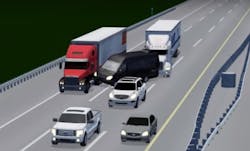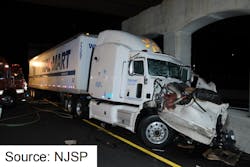A federal investigation has confirmed preliminary reports in last year’s high-profile crash on the New Jersey Turnpike: The truck driver was fatigued at the end of his on-duty period, likely because of an 800-mile commute to his Walmart Transportation LLC terminal the day before, and injuries to the celebrity occupants of a customized luxury van were made worse because they were not wearing seatbelts when the speeding truck rear-ended the van while traffic was slowed in a construction zone.
As a result of its investigation, the National Transportation Safety Board (NTSB) on Tuesday reiterated a 2010 recommendation to the Federal Motor Carrier Safety Administration (FMCSA) to make fatigue management programs mandatory for all carriers.
“Hours of service (HOS) rules cannot address what drivers do on their own time,” said NTSB Chairman Christopher A. Hart, noting that the driver, Kevin Roper of Jonesboro, Ga., had been on duty 13.5 hours of his 14-hour workday, and had been awake more than 28 hours at the time of the crash. “Fatigue management programs can help. To its credit, Walmart has taken steps to bolster its driver fatigue education and policies since this crash.”
Among the occupants of the 2012 Mercedes-Benz limo van, actor/comedian Tracy Morgan, a former "Saturday Night Live" and "30 Rock" star, was seriously injured and comedian James McNair was killed in the first of several collisions that ultimately involved 21 people and six vehicles.
The federal safety watchdog, which has no regulatory authority, reiterated a recommendation to the FMCSA to require coach operators to give pre-trip safety briefings to passengers on the importance of safety equipment and how to exit the vehicle in an emergency. The board also called on FMCSA to finalize its research to evaluate integrated onboard systems, including fatigue-monitoring technologies.
"One tragic aspect of roadway deaths is that so often they could have been prevented," Hart said.
Criminal charges against Roper were filed in New Jersey, while Walmart settled civil suits with Morgan and two other injured passengers for an undisclosed amount earlier this year, and paid a $10 million wrongful death claim by McNair’s children.
The accident also received a lot of attention on Capitol Hill, coming as the U.S. Senate was debating legislation to suspend the restart provisions of the 2013 HOS rule. Sen. Cory Booker, a New Jersey Democrat, led the fight to block the rollback and cited the crash as a reason to strengthen driver hours regulations instead of loosening them. The spending bill to which the language was attached stalled on procedural matters, but the HOS provision was eventually included in the year-end federal budget appropriation.
Sen. Richard Blumenthal (D-CT), who fought the restart suspension with Booker, reinforced his position Tuesday.
“Today’s meeting of the NTSB underscores a sad and tragic fact we already know: a tired trucker is a dangerous driver, capable of turning a big rig into a killing machine,” Blumenthal said. “Allowing more tired truckers on our roads will only lead to more accidents like the horrific accident that injured Tracy Morgan last year.”
He also criticized the Senate for recently passing a highway bill “full of special interest gifts to the trucking industry.”
“The most troubling of which would allow 18-year olds to drive these monster trucks on little rest,” Blumenthal said. “We can and must do better. Lives depend on it.”
Similarly, Daphne Izner—who founded Parents Against Tired Truckers (PATT) after a Wal-Mart truck driver fell asleep at the wheel causing the accident that killed her son—said she was “saddened” that “the economic interests of the trucking industry have prevailed,” despite the ongoing efforts of highway safety groups.
“I am not surprised, however, that once again a Wal-Mart truck has forced other families, like the McNairs and the Morgans, to deal with the devastating effects of preventable, fatigue-related truck crashes,” Izner said.
An NTSB animation of the June 7, 2014 accident, which occurred at about 1 AM near Cranbury, NJ, is below:
The NTSB also issued new safety recommendations to the Federal Highway Administration, the National Highway Traffic Safety Administration, the New Jersey Department of Health, the New Jersey State First Aid Council, the National Limousine Association, Walmart Transportation LLC, Bendix Commercial Vehicle Systems LLC, Detroit Diesel Corporation, and Meritor WABCO Vehicle Control Systems.
These recommendations address issues including improving work zone safety, recording data from in-vehicle collision warning and avoidance systems, increasing seat belt and proper head restraint use in passenger vehicles, and creating a standard for emergency medical system training and practices for emergency responders on the New Jersey Turnpike.
About the Author
Kevin Jones 1
Editor
Kevin has served as editor-in-chief of Trailer/Body Builders magazine since 2017—just the third editor in the magazine’s 60 years. He is also editorial director for Endeavor Business Media’s Commercial Vehicle group, which includes FleetOwner, Bulk Transporter, Refrigerated Transporter, American Trucker, and Fleet Maintenance magazines and websites.

